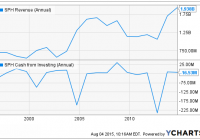Tag Archives: gas-utilities
Clean Energy Fuels (CLNE) Q3 2015 Results – Earnings Call Webcast
High Yield In Focus: 9.53% From Suburban Propane Partners
Summary Suburban Propane Partners is not impacted by commodity downturns. The company has a capital-light business model. Growth opportunity is limited, but SPH can increase distributions via accretive acquisitions. Suburban Propane Partners (NYSE: SPH ) is an MLP that markets and distributes energy products. In addition to propane, the company also sells fuel oil and electricity. As a reseller of energy, the company was not dramatically impacted by the recent commodity downturn. Given that SPH hasn’t missed a single dividend over the past 10 years and has grown the distribution from $0.6125 per quarter in 2005 to $0.8875 per quarter today (45% increase), would now be a good time to buy the stock at a yield of 9.53%? Largely A Propane Business Propane accounts for the highest percentage of the total revenue, coming in at 83%. The propane segment also constituted more than 100% of the total operating income in 2014. How is that possible you ask? That’s because other segments are actually losing money on a GAAP basis. For example, the “All Other” segment has been losing money for three years in a row ($17 million in 2012, $26 million in 2013 and 2014). Evidently, although the company offers a variety of products, the core business still revolves around the sale of propane. Propane use is heavily dependent on the weather. To illustrate, the company sells approximately two-thirds of its retail volume from October to March (the cold months). Of course, this means that warmer weather will directly affect the bottom line. This will introduce some uncertainty to our cash flow in the short term, though this fluctuation should even out in the long run when colder weather returns. Financials The company generated $226 million of operating cash flow ($248 million after adjusting for working capital changes) in 2014. This amount was very close to the company’s distribution of $211 million. This means that the company is pretty much paying out everything that it earns, which is great for income investors. Unlike other popular MLPs (e.g., midstream), the company’s operations are not capital intensive. There are no pipelines to be laid or other growth projects that would require large capital spending. This has allowed the company to keep net maintenance capital expenditure at around $20 million per year. So we have a capital-light company that is generating high cash flows. But growth opportunity is rather limited. Let’s look at the chart below. Although revenue has increased significantly, the growth was not attained organically. Jumps in revenue in 2004 and 2013 can be attributed to the acquisition of Agway Energy and Inergy Propane, respectively. But this should not faze you, as the company has increased normalized operating cash flow per share from $2.41 in 2004 to $4.08 in 2014. Ultimately, dividends depend on cash flow generation, and the fact that these acquisitions were accretive means that the company could afford to increase dividends. So the question is, can the company continue to make accretive acquisitions? The answer is quite complicated, as it depends on a multitude of factors, including but not limited to the skill of the management and the existence of opportunities. We can somewhat gauge the former by looking at how major acquisitions have turned out. Judging by the outcomes described in the previous paragraph, the management seems to have made the right decisions. As for the existence of opportunities, this is completely out of management’s control and depends on market sentiment. When assets are valued cheaply, it creates opportunity. Unfortunately, we don’t know when and how it will happen, so this is a big question mark. One thing we do know is that the management is looking for acquisition opportunities, as they’ve stated that they “seek to extend our presence or diversify our product offerings through selective acquisitions.” The fact that the management looks for “businesses with a relatively steady cash flow” should also provide you with some assurance. Another question you may have is that if the company is paying out everything in cash, where is it getting money to complete acquisitions? Well, management completes deals by raising additional debt and equity. For example, for the recent Inergy acquisition worth $1.8 billion, the company raised $1 billion in debt and paid the rest with cash and stock. The debt may seem high, but the company earns more than enough to cover the interest expense. Looking at the chart below, we can see that the interest coverage ratio has generally been above 1.5x. If we add the non-cash expenses back, the cash coverage ratio would be even higher. This means that the company should be able to maintain the current capital structure. Takeaway The company runs a stable business and sells a product that will always be in demand. Its operation is not capital-intensive, allowing it to pay out much of its operating cash flow. While you shouldn’t expect an increase in dividends without an acquisition, the company is capable of maintaining the current distribution. Keep an eye on acquisition announcements; if history is a good indicator, you should expect dividend increases to follow. However, even if we look at the stock right now, it is hard to argue with its current yield. If you are satisfied with a near-10% yield, then now may be a good time to consider Suburban Propane Partners for your portfolio. Disclosure: I/we have no positions in any stocks mentioned, and no plans to initiate any positions within the next 72 hours. (More…) I wrote this article myself, and it expresses my own opinions. I am not receiving compensation for it (other than from Seeking Alpha). I have no business relationship with any company whose stock is mentioned in this article.
